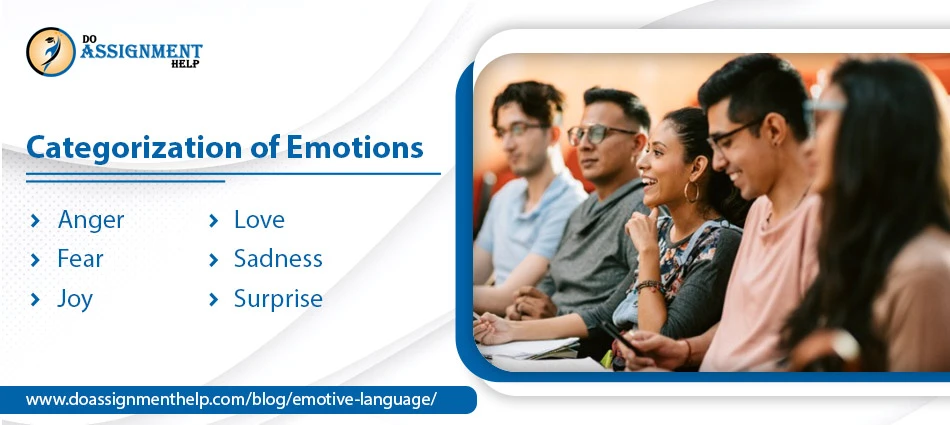Language is the medium through which people express their varied emotions, thoughts, ideas, and opinions. Emotive language targets an emotion. The emotion can be negative, positive, or neutral. It’s used to make readers react emotionally to the presented problem or concept. When your emotion gets transmitted through sentences or words, the language you use to achieve that is emotive or emotional. In this article, you’ll understand in detail about this language, where it is used, and how you can improve it.
Table of Contents
“You can never understand one language until you understand at least two.”
Geoffrey Willans
What Do You Mean by Emotive Language?
To understand this language better, you should begin by knowing the emotive language definition. It’s a sort of language that brings out or evokes an emotional response in the reader. For it, it’s essential to pick words carefully that do the work of passing on the emotions.
This language is used in various story styles and writing forms. As it heavily uses emotions, the readers can better retain the outflows of the writer’s language. It characterizes words that are handpicked to communicate various emotions and trigger an emotional reaction. The terms have powerful negative and positive associations. They all work to trigger different feelings in the reader.
“Change your language and you change your thoughts.”
Karl Albrecht
What are the Different Emotive Language Examples?

The use of this language is not restricted to English literature. You can find its examples in various daily conversations around you too. Movies, television shows, and news headlines use this language heavily to captivate the audience. You can understand the effect this language produces through the help of the various examples below.
1. A naïve teenager was murdered coldheartedly in downtown Toronto.
Here, ‘ naïve’ and ‘coldheartedly’ are emotive language examples.
2. People inflicted with injustice suffer from grievous pain.
Here, the words ‘inflicted’ and ‘grievous pain’ are examples of this type of language.
3. The powerless victims were attacked in the dead of night.
Here, the words’ powerless victims’ and ‘dead of night’ are examples of emotional language.
This type of language is designed to communicate the facts to the reader or the listener. It influences them to favour the author’s opinions. You can better understand what is emotive language when you compare sentences having non-emotive words and emotive words.
- Non-Emotive – Another person on the road was injured by a speeding vehicle.
- Emotive – An innocent person on the road became a miserable victim of a speeding vehicle.
- Non- Emotive – The government is planning to minimize interest rates.
- Emotive version – The government is headed to slash the interest rates.
- Non – Emotive – Mr Jones was attacked by Mr Lawrence for a couple of minutes.
- Emotive – For what seemed like an eternity, Mr Jones was exacted to a brutal assault by the monster of a man, Mr Lawrence.
Categorization of Emotions

There are numerous emotions that human beings experience every day in their life. Emotional language makes use of various emotive words. So, if you want to enhance your writing skills in a way that you are able to make the right impact on your audience, you need to know what are emotive words. The more of them you have in your vocabulary, the more quickly you will be able to communicate your message.
Emotions are broadly categorized into six categories. Here is the list of emotions and their categorization.
Anger
- Disgust
- Contempt
- Repulsion
- Envy
- Jealous
- Exasperation
- Frustration
- Irritation
- Agitation
- Grumpiness
- Rage
- Anger
- Bitterness
- Loathing
- Resentment
- Outrage
- Spite
- Vengeful
- Wrath
- Fury
- Dislike
- Torment
Fear
- Horror
- Fright
- Hysteria
- Panic
- Terror
- Alarm
- Anxiety
- Distress
- Nervousness
- Uneasiness
- Worry
- Dread
Joy
- Cheerfulness
- Bliss
- Delight
- Elation
- Euphoria
- Gladness
- Ecstasy
- Glee
- Gaiety
- Contentment
- Pleasure
- Enthralment
- Rapture
- Eagerness
- Optimism
- Hope
- Relief
- Pride
- Enthusiasm
- Exhilaration
- Zest
- Excitement
- Thrill
Love
- Adoration
- Attraction
- Compassion
- Liking
- Tenderness
- Sentimentality
- Love
- Affection
- Longing
- Lust
- Passion
- Infatuation
- Desire
Sadness
- Disappointment
- Dismay
- Alienation
- Dejection
- Home sickness
- Displeasure
- Isolation
- Insecurity
- Rejection
- Defeat
- Depression
- Gloom
- Despair
- Melancholy
- Sorrow
- Woe
- Hopelessness
- Shame
- Remorse
- Guilt
- Agony
- Regret
- Hurt
- Anguish
- Suffering
- Pity
- Sympathy
Surprise
- Astonishment
- Amazement
What Do You Mean by Connotation?
Connotation implies what is suggested by a language. It refers to the additional meaning that goes over a literal interpretation. Varied words carry varied associations. Thus, it’s important to be cautious while selecting words if you want to trigger a particular reaction in your audience.
A simple method to comprehend this concept is through colour association. Everyone associates the shade red with passion and anger. White is associated with purity, while black with death. At times, the writer or speaker will deliberately play with connotation to direct their audience’s attention or subvert it from a specific issue.
Analyzing Connotations and Emotional Language
Now that you are relatively familiar with what is emotive language, you can try to analyze it and the connotations. First, consider the kind of emotional response the speaker wants to elicit from their audience. After that, determine how the response associates with the entire argument of the speaker.
Another crucial factor to focus on while analyzing language is the placement of emotive phrases and words. If a speaker begins with phrases that communicate his anger, it might turn off his audience. On the other hand, it can also create a scene with which the audience desires to identify.
While you are analyzing a text that uses this sort of language, you need to ask yourself certain questions. They include the following.
- How the usage of emotional language modifies in accordance with the argument.
- Does the emotional language amplify or subdue according to the topic that is being elaborated on?
- What types of connotations would the varied audience segments respond to?
Keep in mind that gender, spiritual beliefs, socio-economic aspects, and age all greatly influence the impact that emotional language and connotations can generate on a particular audience. One person can positively process a text, whereas another person can process it completely differently. It is because of their different backgrounds.
You need to focus on the intent as well as execution of emotional language and connotations in any writing piece that you are analyzing. Then, describe their impact on the people. There are various ways you can analyze an argument and language. Assessors want to find how well-supported and independent your ideas are.
What Do You Mean by Emotive Adverbs?

Adverbs refer to those words that change an adjective, verb, or another adverb. Adverbs are used to give a description of how an action was performed. Their descriptive makes them valuable tools in emotive language. Adverbs are also used to describe the particularities of an action. These are adverbs of frequency, which explain the number of times a particular action was performed.
Yet another one is adverbs of degree, which communicate to another person how strongly an action had occurred. Some emotive adverb examples are here (below) for your reference.
- Brilliantly
- Proudly
- Lazily
- Completely
- Stupidly
- Wholly
- Happily
Where Can You Find the Usage of Emotive Language?

This type of language is prominently used in various domains. You can find an example of emotional language almost every day of your life. Below are the various places where this type of language plays a huge role.
- Poems – You can find this language in almost every sonnet. Poets use it as it effectively transmits the feelings they are trying to express through their words to the one reading it.
- Promotions – Marketers and advertisers use emotional language to stimulate specific emotions in people’s psyche. They do it with the purpose of making them interested in their product or service.
- Books – Books of all genres utilize emotive words and sentences to describe the life of various characters in a story. The use of this language enables a reader to feel more closely what the book’s characters feel.
- Addresses – Public figures often give addresses that are full of emotional words and phrases. They exert a tremendous influence on the psyche of those listening to them.
- Films – Films also use emotional words and phrases in the dialogues so that the audience remains interested in watching them.
- Public announcements – Public announcements are usually made for the benefit of people. These announcements aim to strike emotions in people so that they realize the change that has been made.
- Advertising trademarks – You can find emotive words and phrases in marketing mottos. It allows advertisers to make intriguing mottos by using a small number of words.
- Diaries – Many people write diaries where they pen down their emotions and feelings. They also use emotive sentences in doing so. The sentiments expressed by people in their diaries are full of emotional language.
Why Using Emotional Language Is Necessary
People use this sort of language to understand the mind-set of things and the people that make up the details of a story. The words that bring forth emotions engage the audience and allow them to understand the writing style of the author. It also develops appropriate emotional responses and enables them to connect with what is being described. This writing style is also imperative to deal with the relation between the author’s intent and the readers.
Emotions like love, happiness, anger, embarrassment, jealousy, confidence, pride etc., can be used whenever you find yourself at a loss of words to communicate your feelings and thoughts. Some advantages of using this sort of language include the following.
- It allows the readers to engage better with the story.
- The usage of this language arouses feelings in the audience.
- It allows the reader to forge a deep connection with the story’s characters.
- Emotional language is immensely helpful to all writers as it functions as a persuasive tool.
- The writers can easily and efficiently communicate information of the characters.
- This type of writing helps readers understand various characters’ cultural backgrounds.
Key Guidelines for Using Emotional Language
It’s important not to overuse this language or use the wrong words. It’s because when you make the wrong choice of words, they lose their significance, and your sentence becomes meaningless. So, you need to follow certain guidelines when integrating emotive phrases and words in your writing.
- Use emotive language fallacy. Don’t use too much of this language, as it will only create an emotional overload on your audience.
- Refrain from using ambiguous words – When you use such words, you cannot evoke any feeling in your readers. They become unsure about what is it that you want to say.
- Keep your words and sentences as simple as possible. It will allow the reader to discover precisely how you are feeling. If you use confusing words, you will only go on to over complicate your writing.
- You can also use emotive words to prompt action from your readers. Use the power of this language to get those actions done from your readers, which they otherwise would not do. For instance, anger triggers frustration, which can force others to take prompt action.
- When you are writing about another person’s work, keep in mind that it’s their passion that leads them to it. So, you can use emotive words like hope and admiration to communicate your respect for their commitment, dedication, and hard work.
How to Boost the Skill of Emotional Language
This sort of language brings forth various emotional transitions among people. For instance, a harsh statement has the effect of hurting an innocent person. The language can also boost happiness with information that feels genuinely heart-warming. But for it, you need to use the right phrases or words that conform to the situation.
The most effective method to do it and enhance your emotional language writing skills is to grow your emotional jargon. Undertake extensive research, read more and increase your vocabulary. You can also find various blogs and articles online with different expressive words.
Final Words
You can enable your readers to identify better with your work by using the correct emotive language. A descriptive work strongly impacts the audience by stimulating their senses and causing them to take action. This dynamic and persuasive writing style facilitates the audience to become more receptive to your thoughts, ideas, and opinions. Try to expand your emotive vocabulary to better express yourself and make your communication and messages more impactful.
Related Topic:
A Complete List of Linking Words
 Santa Clara, CA 95050
Santa Clara, CA 95050 





